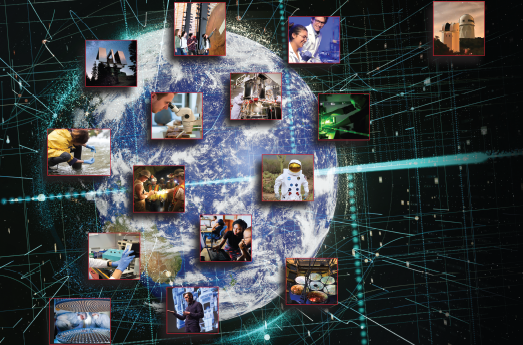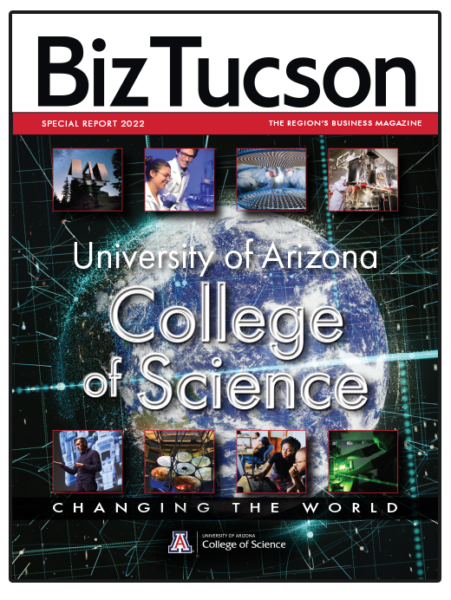
UArizona College of Science Changing the World
Discovery and Innovation at the Core of UArizona’s ‘Most Important College’
By Mary Minor Davis
With more than 8,000 students and 18 degree programs, the University of Arizona College of Science anchors nearly all of the world- and life-changing research done at UArizona, says President Robert C. Robbins.
Its 15 departments, four schools and five major disciplinary areas of study intersect at some point with the entire UArizona community.
“The College of Science, in the past decade, has become the most important college,” Robbins said. “The coming together of the physical, biological, aerospace, digital and behavioral sciences is tremendous and provides the foundation from which all of the collaborative research that occurs at the university is conducted.”
In 2021, U.S. News and World Report ranked UArizona as one of the top 100 research institutions in the world, coming in at 99 out of over 1,700 institutions. It ranks number 42 in the United States and number 22 among public universities.
Carmala Garzione, a geologist who was named dean of the College of Science in March 2021, said one of the most remarkable characteristics of the college is that “every single program has its strengths in research, and most are highly ranked in terms of their curriculum. There’s not a single asset that isn’t a treasure.”
The latest rankings for UArizona programs from the National Science Foundation put astronomy and astrophysics at No. 1 in the U.S., physical sciences at No. 5 and NASA-funded activity also at No. 5. Also, within the College of Sciences, biological and biomedical sciences was ranked No. 21, geosciences, atmospheric sciences and ocean sciences were No. 29, science and engineering fields were No. 35, life sciences and chemistry each came in at No. 39 and computer and information sciences were ranked No. 45.
“At the heart of this success are our faculty and researchers, whose creativity and determination drive discovery and innovation, creating positive, real-world impacts and knowledge for a more resilient future” said Betsy Cantwell, SVP for research and innovation.
Robbins said the College of Science − and UArizona as a whole − is well positioned to lead the Fourth Industrial Revolution, or 4IR. 4IR is known as the convergence of the physical, biological and digital worlds, and experts believe it will dominate our work and home lives in the future.
With this infrastructure in place, the challenge looking forward is to ensure investment in the core facilities so that new knowledge discoveries can be made, translated into making the world a better place, Robbins said.
“We have the reputation as a world-class university and the College of Science is recognized as a world-class leader in many areas,” he said. “We need to retain that reputation to continue to attract talent in both faculty and students.
“Underpinning all of the other areas at the University is a strong foundation for humanities and the sociological sciences that provide the fundamental multiplier. These will all support training the next generation into making the world a better place.”
Physics and Space Sciences
Thanks to its world-renowned astronomy and lunar and planetary sciences departments, UArizona has been at the forefront of space science since 1923 when the Steward Observatory on the main campus was officially dedicated. Today, students investigate the properties of time, solids, liquids and gases to gain a deeper understanding of the universe.
UArizona ranked top 10 for Space Science in the 2021 U.S. News & World Report’s Best Global Universities, ranking No. 2 among public U.S. universities and number 10 in the world.
“It is gratifying to see the University of Arizona listed alongside many of the world’s premier academic research institutions,” said Robbins at the time the ranking was announced last October. “Our university is home to many breathtaking scientific innovations, and it is upon this foundation that our faculty members seek to make further extraordinary discoveries.”
Neural, Cognitive & Behavioral Sciences
“We have a lot of strength and diversity of research and education in mind, brain, and behavior,” Garzione said of the Neural, Cognitive, and Behavioral Sciences programs. “The University of Arizona was recently awarded a $60 million grant from the National Institutes of Health to create and lead a national network on precision aging to better understand the effects of aging on the brain in different people and develop more effective treatments. It’s just one example of the power of our myriad strengths across psychology, neuroscience, cognitive and health sciences in general.”
Life & Molecular Sciences
Life and molecular science take an integrative approach to the study of cells, genetics, chemistry and biochemistry. Through curricula, lab research, field studies and more, faculty and students are challenged with providing interdisciplinary solutions to problems related to disease, the environment, agriculture, engineering, genetic expression, health, quality of life and more.
Earth Sciences
The College of Science’s earth sciences programs play a critical role in understanding the interplay between natural earth processes and human activity that reveal the impacts of humans on Earth and how to mitigate and adapt to some of the most rapid changes in climate, environment, and biodiversity that our planet has ever experienced.
Garzione said the college has departments and programs in hydrology and atmospheric sciences, geosciences, and tree ring research that are highly regarded both nationally and globally. The combined strengths of these programs enable integration of solid Earth, Earth surface, biosphere, atmosphere, and ocean processes to reveal how these have shaped the long-term evolution of our planet and how human influences are modifying the Earth system today and in the future.”
Mathematics and Computational Sciences
With the explosive growth of computing and all things cyber, the College of Science’s mathematics and computational sciences programs teach students the latest in computer science, applied mathematics, statistics and data sciences methods and applications.
“We provide academic programs in statistics and data science at the undergraduate level, but we are looking strategically at data science at the graduate level that will enable placement of our students at the forefront of research, development, and application of data science methods in industry and academia,” Garzione said.
These methods apply to a broad range of STEM, social sciences, and humanities disciplines are fueling the 4th Industrial Revolution.
Garzione said that on top of continuing to build on strengths in the College of Sciences in the five broad fields of study, the College has the added priority of ensuring that opportunities and support are in place for students that come from virtually any location, background, or lived experience.
“Our efforts now are charting a course for our future that attracts students, faculty, and staff with a diversity of experiences and perspectives that celebrate our diversity and encourage careers in be sciences,” Garzione said. “We believe that diverse perspectives and experiences will enable us to identify our next big research and educational opportunities to ensure that we continually evolve our strengths in a way that makes us highly impactful.”






